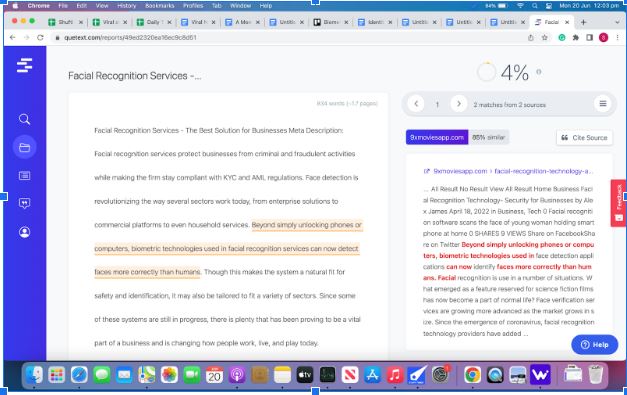Meta Description: Facial recognition services protect businesses from criminal and fraudulent activities while enabling the firm to stay compliant with KYC/AML regulations.
Face detection is revolutionizing the way several sectors work today, from enterprise solutions to commercial platforms to even household services. Beyond just unlocking computers or mobile phones, biometric technology used in facial recognition services can catch fake faces more accurately as compared to humans. Though this makes the system a natural fit for safety and identification, it may also be tailored to fit a variety of sectors. Since some of these systems are still in progress, there is plenty that has been proving to be a vital part of a business and is changing how people work, live, and play today.
How Does Facial Recognition System Work?
The definition of the word “facial recognition” is self-evident. Biometric algorithms are used to map, evaluate, and verify the authenticity of a face in a photograph or video. Despite the fact that each and every face detection systems (which typically focuses on proprietary algorithms) are different, the face recognition process may be divided into 3 steps:
- The term detection means to detect a person’s face in the image. As a result, each face is enclosed by a box. The face recognition algorithms must first be taught to learn how an individual’s face looks on numerous data entries before they can accomplish this stage.
- The term “analysis” relates to the procedure of tracing each face’s attributes. This is achieved by calculating the distance between an individual’s nose, and eyes, as well as checking the chin contour. These measurements are then added together and transformed into a distinct set of integers known as a faceprint.
- The word “recognition” describes the process of identifying a person in a photograph. This level is sometimes replaced by categorization in other applications. In such circumstances, the algorithms don’t really validate a person’s identity, but instead classify them into one of several groupings, like gender or age.
Face Recognition Technology in Different Sectors
Facial recognition is a fantastic technique that allows companies to find and authenticate someone’s identification by looking at their face. Face recognition software can recognize persons in photographs, videos, and even in real-time. It uses computer algorithms to identify certain, distinguishing features on an individual’s face.
Let’s look at how Shufti Pro services like a face verification solution are used in many sectors.
-
Retail
Facial recognition can be utilized in the retail industry to record what consumers are searching for. This will aid retailers in delivering targeted promotions to customers via email or internet marketing. Online face verification combined with advanced algorithms will make businesses, particularly beauty brands, more data-rich.
-
Hotel
In the hospitality sector, face recognition improves client service. Restaurants and hotels can initiate a patron’s check-ins as they step into the facilities by linking the software to their account.
-
Events and Entertainment
Client face verification and tracking systems are used by gaming providers like casinos to uncover cheaters and maintain track of blacklisted gamers. Furthermore, the system is in great demand at concerts and sporting events since it can detect and identify terrorists.
- Air Travel
Face detection, similar to its use in the hotel business, might speed up the process for everyone and potentially deliver a more personalized experience. Shufti Pro solutions are a great bet that helps in the boarding procedure and makes regular entry easier.
-
Banking
By decreasing friction, banks may improve productivity and usefulness for their customers with facial recognition. It aids in avoiding unauthorized entry to restricted sections of a bank as well as capturing strange behavior on video.
-
Automobile
Facial recognition software is slowly creeping into the automobile market in an effort to increase comfort and security. Face recognition has a variety of applications in this industry, extending from car unlocks to theft prevention.
-
Education
In the educational sector, facial biometric recognition is utilized to track students and manage attendance records. It could provide information on the reaction of the crowd throughout classes. Face recognition could also aid security by tracking who enters and exits the organization on a routine basis.
-
Ride-sharing
Face recognition can detect signs of exhaustion in ride-sharing drivers as well as restrict them from accepting any other rides. It also helps to reduce the number of fatal road accidents caused by tired cab drivers.
Final Thoughts
Facial recognition services have been around for so many years, and it is now one of the most potent tools for enhancing security. Clients can be onboarded smoothly, CDD standards can be met, and the company’s current overall security can be improved. Facial recognition technology is also useful for spotting thieves at border crossings and airports. Shufti Pro founder Shahid Hanif and CEO Victor Fredung have introduced a face detection engine and it is a one-stop solution for all firms. It is coupled with thousands of AI models and detects spoof attacks and deep fakes in a matter of seconds.
